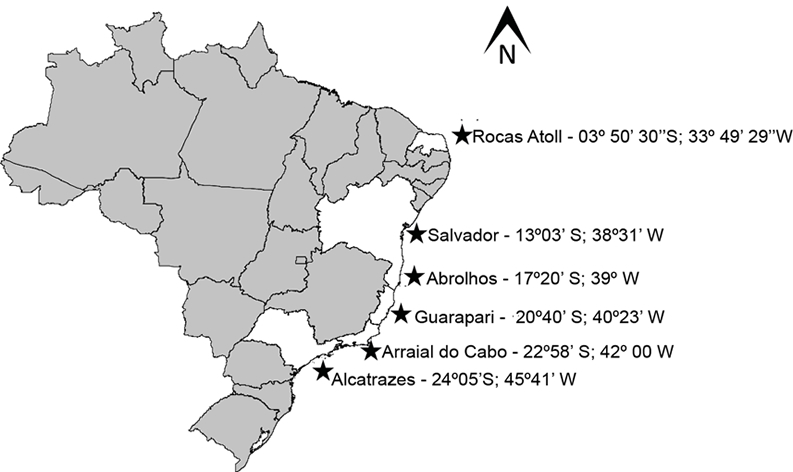 Latitudinal trends on function, demographic structure and nutritional ecology of herbivorous fishes along Brazilian coast Latitudinal trends on function, demographic structure and nutritional ecology of herbivorous fishes along Brazilian coast
CNPq Nº 71‐2013 – Fellow Special Visitor Researcher
The growing anthropogenic impacts on coastal ecosystems are causing a worldwide loss of taxonomic, phylogenetic, genetic and
functional diversity. This damage directly affects the biodiversity crucial to maintain the health and resilience of ecological processes
within natural ecosystems. Results of these impacts have been shown for ecosystems worldwide, and the degradation scenario and
loss of biodiversity at the Brazilian coast are no different. Overfishing is one of the most important drivers of marine biodiversity loss. After
removal of top predators from marine food webs other trophic groups are usually targeted, such as large-sized herbivorous fish that are
essential for equilibrium of coral reef ecosystems.
Having a wide latitudinal gradient, from tropical to subtropical, the Brazilian coast harbors a different community composition of
nominally herbivorous fish in terms of abundance along this gradient, with a high level of endemic species, with some of these
performing crucial functional roles. The unique features of Brazilian reefs, in addition to the scarcity of information on the ecology of
herbivorous fishes in these systems, makes the proposed study fundamentally important to a better comprehension of how these fishes
function as key stone species for maintaining of essential ecological functions and improving resilience of these systems. Therefore,
the goal of this project is to understand the trophic ecology of nominally herbivorous fishes seeking to understand the relationship
between food items intake and nutrient assimilation, allowing us to reconsider previous functional trophic classifications of herbivorous
fishes. Further, to investigate influence of latitudinal patterns on nominally herbivorous fishes, our data will also evaluate correlations
between nutritional ecology and growth curves of nominally herbivorous fishes, pursuing environmental features that may influence and
drive this correlation, as temperature varies from tropical to subtropical sites. For this, the project includes several approaches, including
otolith analysis for growth curves, and pre and post-ingestive tools for nutritional ecology. Pre-ingestive approach will mainly examine
feeding behavior of fish species as bite rates counts. To study the post-ingestive ecology, a still not applied methodology on herbivorous
reef fishes at Brazilian coast, stable isotope analysis (SIA), will be performed aiming to understand latitudinal trends and patters that
drive the nutritional ecology of nominally herbivorous fishes. This kind of latitudinal comparison has never been performed earlier on
such a wide gradient, covering both tropical and subtropical environments.

Fish species selected for the latitudinal gradient study: a) Acanthurus chirurgus, b) Kyphosus sectatrix and c) Sparisoma axillare.
Sampling sites were selected to encompass a wide latitudinal gradient. At each site demographic structure, diet, and nutrient
assimilation for the three selected herbivorous reef fish species, will be evaluated. The three study species (A. chirurgus, K. sectatrix and
S. axillare) represent different taxonomic families, diet, and food processing modes. Indeed, previous studies have identified different
abundance pattern of the selected species in relation to latitudinal gradient, with surgeonfishes (Acanthurus chirurgus) and parrotfishes
(Sparisoma axillare) being more abundant at tropical reefs, while drummers (Kyphosus sectatrix) are more abundant towards
subtropical environments. But processes that drive distribution patterns of marine herbivorous fishes remain uncertain. We hope that
results and insights from this project will provide major breakthroughs on our understanding of dynamics of interactions and structuring
processes of the unique tropical and subtropical reef systems in Brazil, and being useful to support management of conservation of
these three key stone species, and of Brazilian reef systems.

Sites to be sampled for latitudinal trends in marine herbivorous reef fishes at the Brazilian coast, representing tropical (Rocas Atoll,
Salvador and Abrolhos) and subtropical (Guarapari, Arraial do Cabo and Alcatrazes) environments.
.

|









